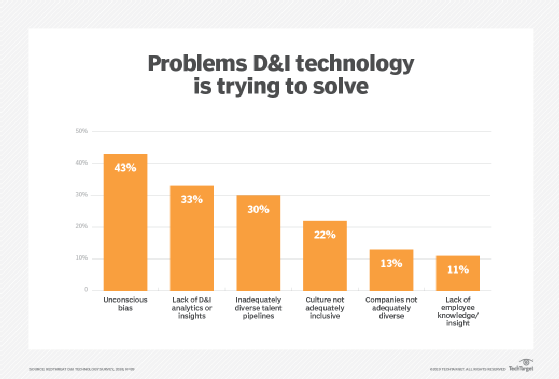
Rawpixel - Fotolia
Technology can aid diversity and inclusion in HCM, with caveats
Vendors are increasingly building AI applications to be bias-free to address concerns around diversity and inclusion. The technology may help raise awareness of inequities that go beyond discrimination.
The fact that business results are better in environments that are both diverse and inclusive is old news. As reported in Harvard Business Review, companies with above average total diversity had an average of 19 percentage points higher innovation revenues and 9 percentage points higher earnings before income and taxes margins, on average. Having a diverse workforce, with acts or practices that provide an equitable and fair distribution of resources, such as jobs, income, opportunities and access to information, is critical.
Is technology the answer? While it seems a bit tenuous to think that technology can overcome years of bias, discrimination and exclusion, the use of AI in technology can further diversity and inclusion.
How technology might help
AI is the hot tech of the day and an area to which human capital management (HCM) professionals need to pay attention. Vendors are redesigning applications to include AI and machine learning, streamlining tasks and lowering overhead in industries such as manufacturing, healthcare and education. Not to be left behind, providers of HCM applications include AI, or purport to, as a way to address recruiting, succession and other talent-related functions. In this effort, many specifically address diversity by attempting to render the application process bias-free. RedThread reported that, of the talent management areas that diversity and inclusion technology providers focus on, the largest percentage of tools focus on talent acquisition (43%), one of the predominant areas for which AI is applied in newer HCM products. In the same way that musicians audition behind a screen for bias-free hiring in a symphony, these applications claim to ignore color, ethnicity and gender and present applicants based on skills.
Is it a start? Yes, when used properly and in the right hands. However, there are several issues. Machine learning learns from data, and the recruiting data fed into the system may be based on generations of successful applicants for a position -- which may have been predominantly white males. Corporate data is of necessity related to the past; even with predictability built in to the application, no one has been able to create a program that can guarantee a successful and diverse candidate. Secondly, any computer system is created by someone, and the biases of the programmer may be built into the program itself. Both issues militate against an AI-driven, bias-free recruiting process. However, one may argue that it may be a step in the right direction overall if intelligently used.
RedThead reported on the types of issues HCM vendors are creating software to solve, some of which use AI in their applications. Unconscious bias is the primary one, reported by 43% of the vendors. It would be a boon if technology could provide bias-free input to hiring, promotion, succession and other such HR decisions.
Beyond bias, however, the predominant use appears to be fostering analytics that HR can use to demonstrate the need for better diversity and inclusion. This is an important step in the right direction, as long as the statistics are used to change the status quo in a positive direction.

Existing applications focusing on diversity and inclusion reviewed by RedThread displayed a plethora of useful features, such as anonymizing and removing identifying information from candidate profiles and removing photos in performance reviews.
Future roles for technology in diversity and inclusion
The application of technology to measuring disparities in pay, perks and promotion rates is every bit as important as ascertaining the diversity of a pipeline. Where software may not be able to address inequities, it can at least bring them to the surface, as companies such as Pipeline are doing today. As data shows that a disproportionate number of jobs currently filled by females are at risk given automation, technology has already identified roles at risk. Perhaps it can be put to use matching existing skills with new opportunities or intelligently identifying and providing opportunities for upskilling or redeployment.
Discrimination and inequity in corporations are too deep-seated to lend themselves to easy solutions. Today's software presents a start and will create more awareness to the issues at hand. However, addressing diversity and inclusion -- whether with technology, AI or simply with human attention -- in bits and pieces across the organization may fail to address the incipient enterprise-wide factors that feed inequity.





